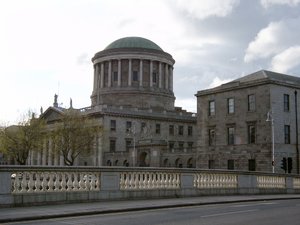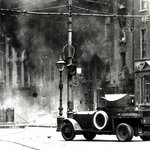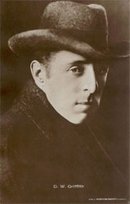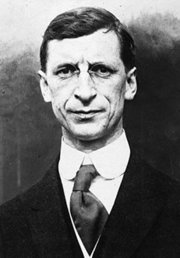Irish Civil War
|
|
The Irish Civil War (June 1922–April 1923) was a conflict between supporters and opponents of the Anglo-Irish Treaty of December 6, 1921, which established the Irish Free State, precursor of today's Republic of Ireland. Opponents of the Treaty objected to the fact that it retained constitutional links between the United Kingdom and Ireland, and that the six counties of Nothern Ireland would not be included in the Free State. The Civil War cost the lives of more than had died in the War of Independence that preceded it. It left Irish society deeply divided and its influence in Irish politics can still be seen to this day.
| Contents |
Background
Firstdail.jpg
The Anglo-Irish Treaty arose from the Anglo-Irish War (or "Irish War of Independence"), fought between Irish separatists (organised as the extra-legal Irish Republic) and the British government, from 1919-1921. The treaty provided for a fully self-governing Irish state, controlling most of Ireland's population and area, and having its own army and police. However, rather than creating the independent republic favoured by many nationalists, it provided that the state would be a dominion of the British Empire with the British monarch as head of state. The treaty also stipulated that members of the new Irish Oireachtas (parliament) would have to take an oath of fidelity, called the "Oath of Allegiance", to the British king. Under the treaty the state was not to be called a republic but a "free state" and it was only to include twenty-six southern and western counties of Ireland. Also, several strategic ports were to remain occupied by the British Navy. Nonetheless Michael Collins argued that the treaty gave "not the ultimate freedom that all nations aspire and develop, but the freedom to achieve it". His enemies were eventually to prove him right, as the Free State later evolved into an independent republic. However, Anti-Treaty militants in 1922 believed that the Treaty would never deliver full Irish independence.
The split over the Treaty was deeply personal. The protagonists on both sides had been close friends and comrades during the War of Independence. This made their lethal disagreement over the Treaty all the more bitter. Michael Collins felt that Eamon de Valera had sent him to negotiate the Treaty because he knew that no more concessions could be got from the British and wanted Collins to take the blame for the compromise settlement. He therefore felt deeply betrayed when De Valera refused to stand by the agreement he had negotiated with David Lloyd George and Winston Churchill.
Dáil Éireann (the parliament of the Irish Republic) narrowly passed the Anglo-Irish Treaty in December 1921. Upon the Treaty's ratification Eamon de Valera resigned as President of the Republic and lead his anti-treaty wing of Sinn Féin out of the Dáil. He challenged the right of the Dáil to approve the Treaty, saying that its members were breaking their oath to the Irish Republic and attempted unsuccessfully to set up his own rival government. Meanwhile under the leadership of Michael Collins and W.T. Cosgrave, the pro-treaty government set about establishing the Irish Free State, an organised national army to replace the IRA and a new police force. Supporters of the treaty came to be known as "pro-treaty", "National Army" or "Free State" forces. Its opponents were known as "anti-treaty", "IRA" or "irregular" forces. The Anti-Treaty IRA claimed that it was defending the Irish Republic, that had been declared in 1916 during the Easter Rising and created by the First Dail and had been un-lawfully usurped by those who accepted the compromise of the Free State. Eamon de Valera stated that he would serve as an ordinary IRA volunteer, and left the leadership of the Anti-Treaty Republicans to military leaders such as Liam Lynch.
Course of the war
Dublin Fighting
In April 1922 anti-treaty militants led by Rory O'Connor occupied the Four Courts in Dublin, resulting in a tense stand-off. The Anti-Treaty Republicans wanted to spark a new armed confrontation with the British, which would unite the two Irish nationalist factions against their common enemy. However, for those who were determined to make the Free State into a viable, self-governing Irish state, this was an act of rebellion that would have to be put down. Michael Collins attempted unsuccessfully to persuade the men holding the Four Courts to leave it before violence broke out. They refused and Collins decided to end the stand-off, under a British threat of re-occupation, by the bombarding the Four Courts garrison into surrender. The building's bombardment and capture by pro-treaty forces from June 28-June 30 proved to be the opening shots of the Civil War.
Michael Collins had accepted a British offer of artillery for use by the new Free State Army. The anti-treaty forces, who possessed only small arms, surrendered after several days of bombardment. In a notorious act, the anti-treaty IRA, before they surrendered the Four Courts, boobytrapped the Irish Public Records Office, blowing to pieces one thousand years of Irish state and religious archives. However, several of them, notably Ernie O'Malley escaped from captivity to continue fighting elsewhere. Pitched battles continued in Dublin until July 5, as anti-Treaty IRA units occupied O'Connell Street - provoking a week's more street fighting. Among the casualties was Republican leader Cathal Brugha. When the fighting in Dublin died down, the Free State Government was left firmly in control of the Irish capital and the anti-treaty forces dispersed around the country.
At the start of the Civil War the IRA had split down the middle. The Anti-Treaty side had considerable support among IRA units, particularly in the south and west of Ireland. However the anti-treaty IRA lacked an effective command structure, a clear strategy and sufficient arms. They were forced to adopt a defensive stance throughout. Michael Collins and his commanders were able to build up an army which was able to overwhelm the Irregulars on the battlefield. British supplies of artillery, aircraft, armoured cars machine-guns, small arms and ammunition were much help to pro-treaty forces. By the end of the war, the Free State Army had swolen to over 55,000 men, far in excess of what the Irish state needed to maintain in peacetime. Collins' most ruthless troops were recruited from the Dublin Brigade of the IRA, (which he had commanded in the Irish War of Independence) and in particular from his assassination unit "The Squad". Towards the end of the war, they were implicated in some gruesome atrocities against Anti-Treaty guerrillas. Most of the Free State Army's officers were Pro-Treaty IRA officers. However, the bulk of the Free State Army was made up of unemployed Irish ex-servicemen, who had fought in the First World War in the British Army.
The Free State takes Major Towns
With Dublin in pro-treaty hands, conflict spread throughout the country, with anti-Treaty forces briefly holding Cork, Limerick and Waterford. However, the Anti-Treaty side were not equipped to wage conventional war, lacking artillerry and armoured untis, both of which the Free State obtained off the British. This meant that the large towns in Ireland were all easily taken by the Free State after only sporadic fighting. On August 10, Cork was retaken by sea. Government victories in the major towns inaugurated a period of inconclusive guerrilla warfare marked by assassinations and executions of leaders formerly allied in the cause of Irish independence. The head of the Provisional Government, Michael Collins was assassinated by anti-treaty republicans in August, near his home in Cork in 19211. Arthur Griffith, the Free State president had also died of a stroke a week or so before, leaving the Free State government in the hands of William Cosgrave and the Free State Army under the command of General Richard Mulcahy.MickC.jpg
Atrocities, Executions and the End of the War
The final phase of the Civil War (1923) degenerated into a series of attrocities that left a lasting legacy of bitterness in Irish politics. The Anti-Treaty IRA began assassinating T.D.s who sat in the Dail, begining with Sean Hales. In response, the Free State announced that it would be shooting IRA prisoners in reprisal for future "outrages". Accordingly, four prominent Republicans (one from each province), who had been held since the first week of the war - Rory O'Connor, Liam Mellows and two others- were executed in revenge for the killing of Hales. In all, the Free State sanctioned 77 official executions of Anti-Treaty prisoners during the civil war, including acclaimed author and treaty negotiator Robert Erskine Childers, - a number that was recalled by Fianna Fail members with bitterness for decades afterwards. In addition, Free State troops, particularly in county Kerry, where the guerrilla campaign was most bitter, began unofficial killings of captured Anti-Treaty militants. The most notorious example of this occurred at Ballyseedy, where 18 Republican prisoners were tied to a landmine, which was exploded and the survivers machine-gunned.
The Anti-Treaty IRA werre unable to maintain an effective guerrilla campaign, since the great majority of the Irish population did not support them. This was demonstrated in the elections immediately after the civil war, which Cumann na nGaedheal, the Free State party, won easily (See Irish general election, 1923 for the results). The Roman Catholic Church also supported the Free State, deeming it the lawful government of the country, denouncing the Anti-Treaty IRA and refusing to administer the Sacraments to Anti-Treaty militants. This stance would have influenced many Catholic Irish people at the time. The lack of public support for the Anti-Treaty IRA, the determination of the government to defeat them and their lack of will also contributed to the their defeat. As the conflict petered out into a de facto victory for the pro-Treaty side, de Valera asked for a ceasefire, followed in May 1923 by an order by the leadership of the Irregulars to dump arms rather than surrender them or continue a fight which they were incapable of winning. Some historians suggest that the death of Liam Lynch, an intransigent Republican leader, in a skirmish in the Knockmealdown mountains in county Waterford, allowed the more pragmatic Frank Aiken to call a halt to what seemed a futile struggle. Thousands of Anti -Treaty IRA members (including De Valera) were arrested by the Free State forces in the weeks after the end of the war, when they had dumped their arms and returned home.
Attacks on Protestants and Loyalists
Although the cause of the civil war was the treaty, as the war developed the irregulars sought to identify their actions with the traditional republican cause of the "men of no property" and the result was that the war also saw large landowners, and some not very well-off loyalists, attacked and a large number of country estates occupied by small holders. Many, but not all of these, had supported the Crown forces during the War of Independence. This support was often largely moral, but sometimes it took the form of actively assisting the British in the conflict. This made their situation post-independence difficult, and in the anarchy of the Civil War they became easy targets. Sometimes these attacks had sectarian overtones, although most IRA men made no distinction between Catholic and Protestant supporters of the Irish government. The Free State made efforts to protect Protestants, most notably in County Louth, where a special police force was set up specifically for this purpose. Controversy continues to this day about the extent of intimidation of Protestants at this time.
Cost and Results
The Civil War, though short, was bloody. It cost the lives of many senior figures, including Michael Collins. Both sides carried out brutal acts: the anti-treaty forces murdered TDs (MPs) and burned yet many historic homes (such as the famous Moore Hall in Mayo, because its owner had become a senator); the government executed anti-treaty prisoners, officially and unofficially. The pro-treaty National Army suffered 800 fatalities and perhaps as many as 4000 people were killed. As their forces retreated the Irregulars caused much destruction and the economy of the Free State suffered a hard blow in the earliest days of its existence as a result. In addition, about 12,000 Republicans were interned by the end of the Civil War, most of whom were not released until 1924.
However, it has also been argued that the Irish Civil War could have been far worse than it actually was. The numbers killed were relatively modest by the standards of other contemporary civil wars - example in Russia and Spain. Moreover, the fact the new Police force - the Gardai were not involved, meant that it was possible for the Free State to establish an unarmed and politically neutral police service after the war.
The fact that The Irish Civil War was fought between Irish Nationalist factions meant that the issue of Northern Ireland was ignored and Ireland was spared what could have been a far bloodier civil war based on ethnic and sectarian lines over the future of Ireland's six north-eastern counties. In fact, because of the Irish Civil War, Northern Ireland was able to consolodate its existence and partition of Ireland was confirmed for the forseeable future. It was only after their defeat in the Civil War that Irish Republicans seriously considered whether to take armed action against British rule in Northern Ireland.
As with most civil wars, the internecine conflict left a bitter legacy, which continues to influence Irish politics to this day. The two largest political parties in the Republic are still Fianna Fáil and Fine Gael, the descendants respectively of the anti-treaty and pro-treaty forces of 1922. Until the 1970s, almost all of Ireland's prominent politicians were veterans of the civil war, a fact which poisoned the relationship between Ireland's two biggest parties. Examples of Civil War veterans include: Eamon de Valera, Todd Andrews, Sean Lemass 2, (Republican) W.T. Cosgrave, Richard Mulcahy and Kevin O'Higgins (Free State). Moreover, many of these men's sons and daughters also became politicians, meaning that the personal wounds of the civil war were felt over three generations. In the 1930s after Fianna Fail took power for the first time, it looked possible for a while that the Civil War might break out again between the IRA and the pro-Free State Blueshirts. Fortunately, this crisis was averted and by the 1950s, political violence was no longer prominent in Southern Irish politics.WTCosgrave2.jpg
However, the IRA continued (and continues) to exist. Up until the 1980s it still claimed to be the Provisional Government of the Irish Republic declared in 1918 and annulled by the Treaty of 1921. Some people, notably Michael McDowell claim that this attitude, which dates from the Civil War, still underpins the politics of the Provisional IRA.
Footnotes
- In the 1996 film Michael Collins, Eamon de Valera orders Collins' death. However, although de Valera was in the area at the time, he is not known to have been involved in the assassination.
2.Whose brother Noel was abducted and shot by Free State forces. His body was dumped in the Wicklow Mountains, near Glencree, where it is marked by a memorial.
Sources
- Ernie O'Malley, The Singing Flame, Dublin 1978.
- M.E. Collins, Ireland 1868-1966, Dulin 1993.




